Corporations Law Essay: Directors' Duties, ASIC, and Insolvency
VerifiedAdded on 2023/06/03
|11
|2163
|449
Essay
AI Summary
This Corporations Law essay analyzes several key aspects of corporate governance and legal responsibilities within the Australian legal framework, referencing the Corporations Act 2001 and the Australian Securities and Investments Commission (ASIC). The essay examines the definition of an officer within a corporation, the avoidance of director liability, and the implications of conflicts of interest. It explores directors' duties, including the exercise of due diligence, acting in the company's best interest, and the prohibition of misuse of position. The essay also addresses issues of insolvency, including directors' duties to prevent insolvent trading, and the liability of individuals who assist in contraventions of the Act. Through case analysis, the essay provides a comprehensive overview of corporate law principles and their practical application.
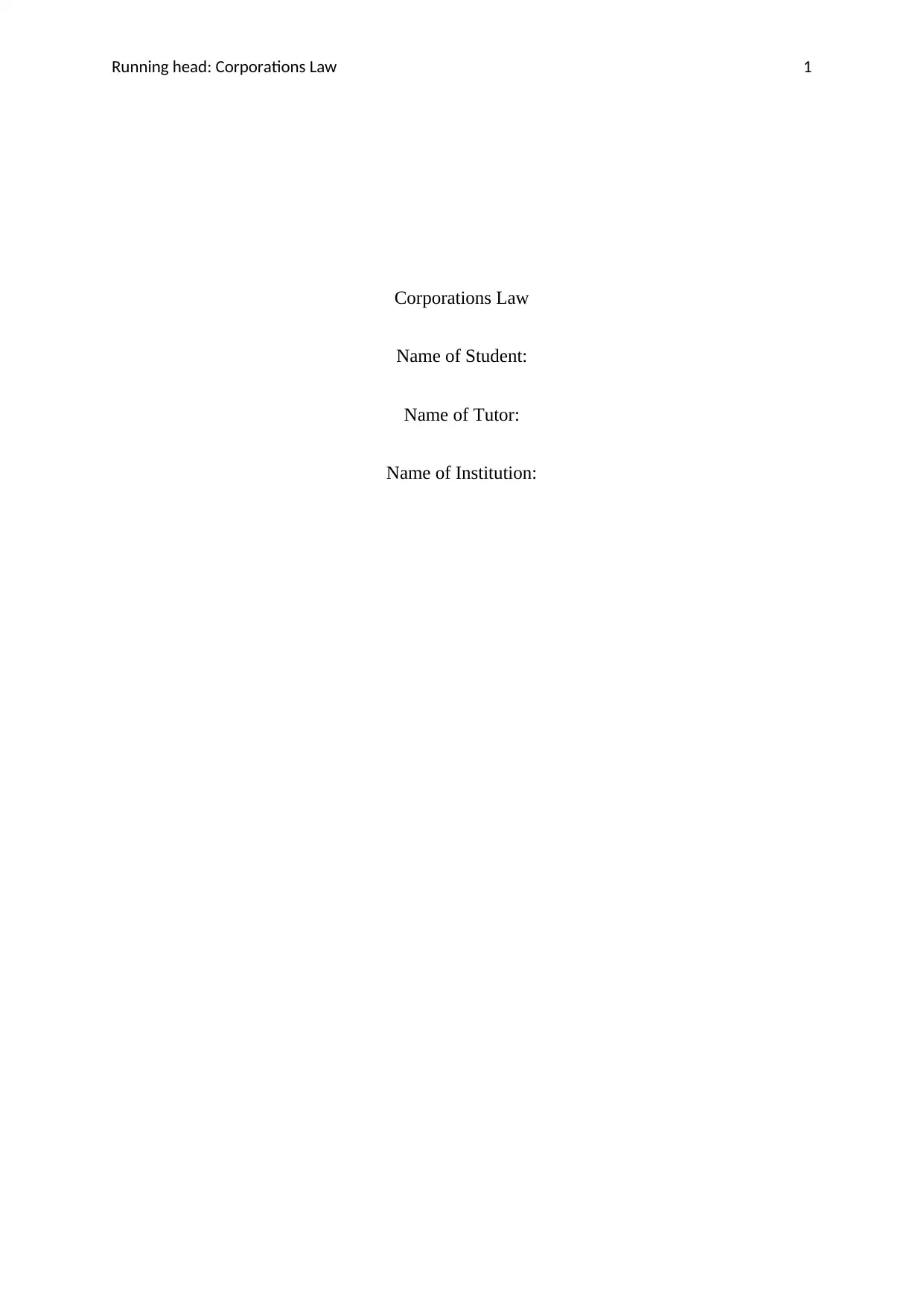
Running head: Corporations Law 1
Corporations Law
Name of Student:
Name of Tutor:
Name of Institution:
Corporations Law
Name of Student:
Name of Tutor:
Name of Institution:
Paraphrase This Document
Need a fresh take? Get an instant paraphrase of this document with our AI Paraphraser
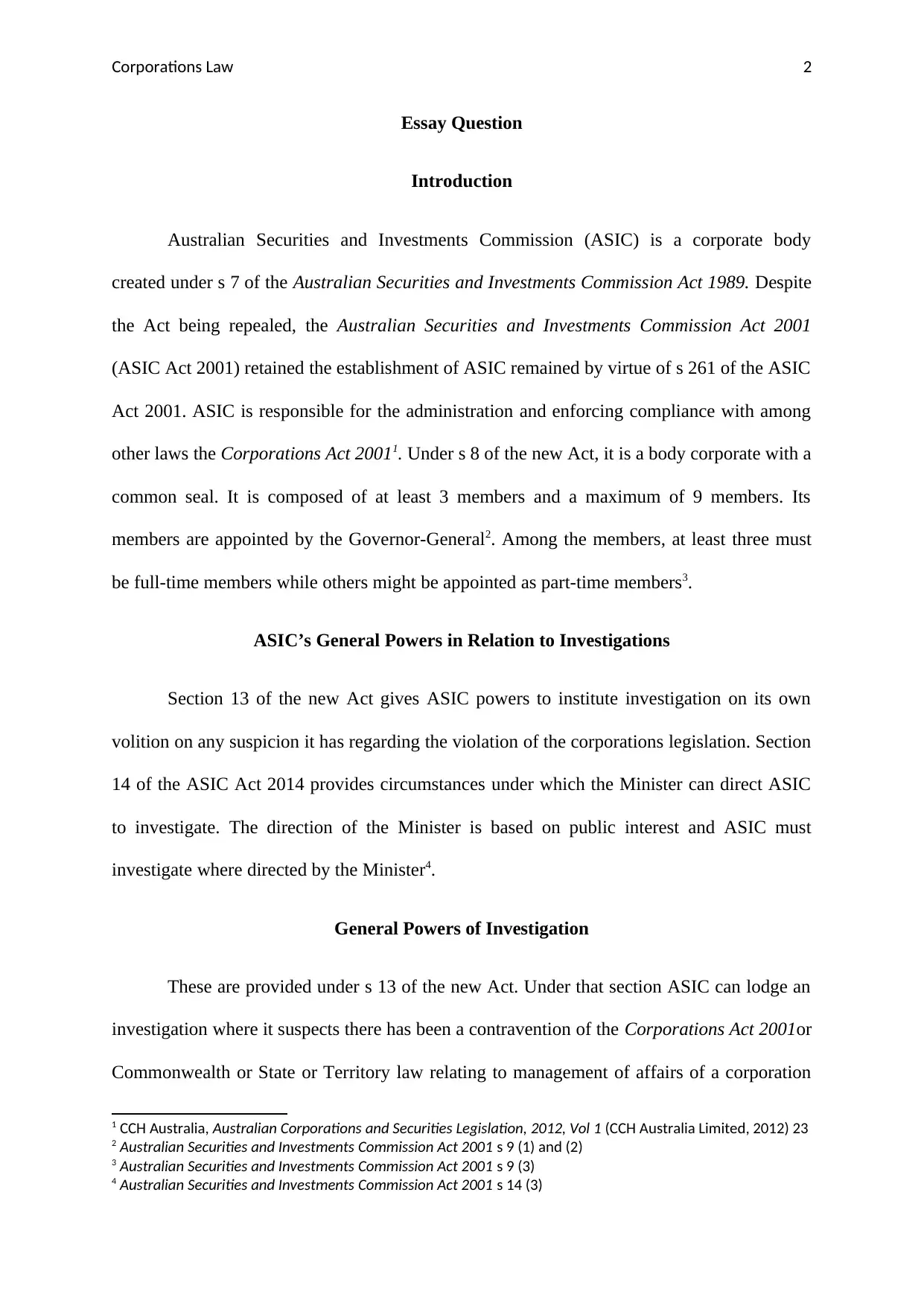
Corporations Law 2
Essay Question
Introduction
Australian Securities and Investments Commission (ASIC) is a corporate body
created under s 7 of the Australian Securities and Investments Commission Act 1989. Despite
the Act being repealed, the Australian Securities and Investments Commission Act 2001
(ASIC Act 2001) retained the establishment of ASIC remained by virtue of s 261 of the ASIC
Act 2001. ASIC is responsible for the administration and enforcing compliance with among
other laws the Corporations Act 20011. Under s 8 of the new Act, it is a body corporate with a
common seal. It is composed of at least 3 members and a maximum of 9 members. Its
members are appointed by the Governor-General2. Among the members, at least three must
be full-time members while others might be appointed as part-time members3.
ASIC’s General Powers in Relation to Investigations
Section 13 of the new Act gives ASIC powers to institute investigation on its own
volition on any suspicion it has regarding the violation of the corporations legislation. Section
14 of the ASIC Act 2014 provides circumstances under which the Minister can direct ASIC
to investigate. The direction of the Minister is based on public interest and ASIC must
investigate where directed by the Minister4.
General Powers of Investigation
These are provided under s 13 of the new Act. Under that section ASIC can lodge an
investigation where it suspects there has been a contravention of the Corporations Act 2001or
Commonwealth or State or Territory law relating to management of affairs of a corporation
1 CCH Australia, Australian Corporations and Securities Legislation, 2012, Vol 1 (CCH Australia Limited, 2012) 23
2 Australian Securities and Investments Commission Act 2001 s 9 (1) and (2)
3 Australian Securities and Investments Commission Act 2001 s 9 (3)
4 Australian Securities and Investments Commission Act 2001 s 14 (3)
Essay Question
Introduction
Australian Securities and Investments Commission (ASIC) is a corporate body
created under s 7 of the Australian Securities and Investments Commission Act 1989. Despite
the Act being repealed, the Australian Securities and Investments Commission Act 2001
(ASIC Act 2001) retained the establishment of ASIC remained by virtue of s 261 of the ASIC
Act 2001. ASIC is responsible for the administration and enforcing compliance with among
other laws the Corporations Act 20011. Under s 8 of the new Act, it is a body corporate with a
common seal. It is composed of at least 3 members and a maximum of 9 members. Its
members are appointed by the Governor-General2. Among the members, at least three must
be full-time members while others might be appointed as part-time members3.
ASIC’s General Powers in Relation to Investigations
Section 13 of the new Act gives ASIC powers to institute investigation on its own
volition on any suspicion it has regarding the violation of the corporations legislation. Section
14 of the ASIC Act 2014 provides circumstances under which the Minister can direct ASIC
to investigate. The direction of the Minister is based on public interest and ASIC must
investigate where directed by the Minister4.
General Powers of Investigation
These are provided under s 13 of the new Act. Under that section ASIC can lodge an
investigation where it suspects there has been a contravention of the Corporations Act 2001or
Commonwealth or State or Territory law relating to management of affairs of a corporation
1 CCH Australia, Australian Corporations and Securities Legislation, 2012, Vol 1 (CCH Australia Limited, 2012) 23
2 Australian Securities and Investments Commission Act 2001 s 9 (1) and (2)
3 Australian Securities and Investments Commission Act 2001 s 9 (3)
4 Australian Securities and Investments Commission Act 2001 s 14 (3)
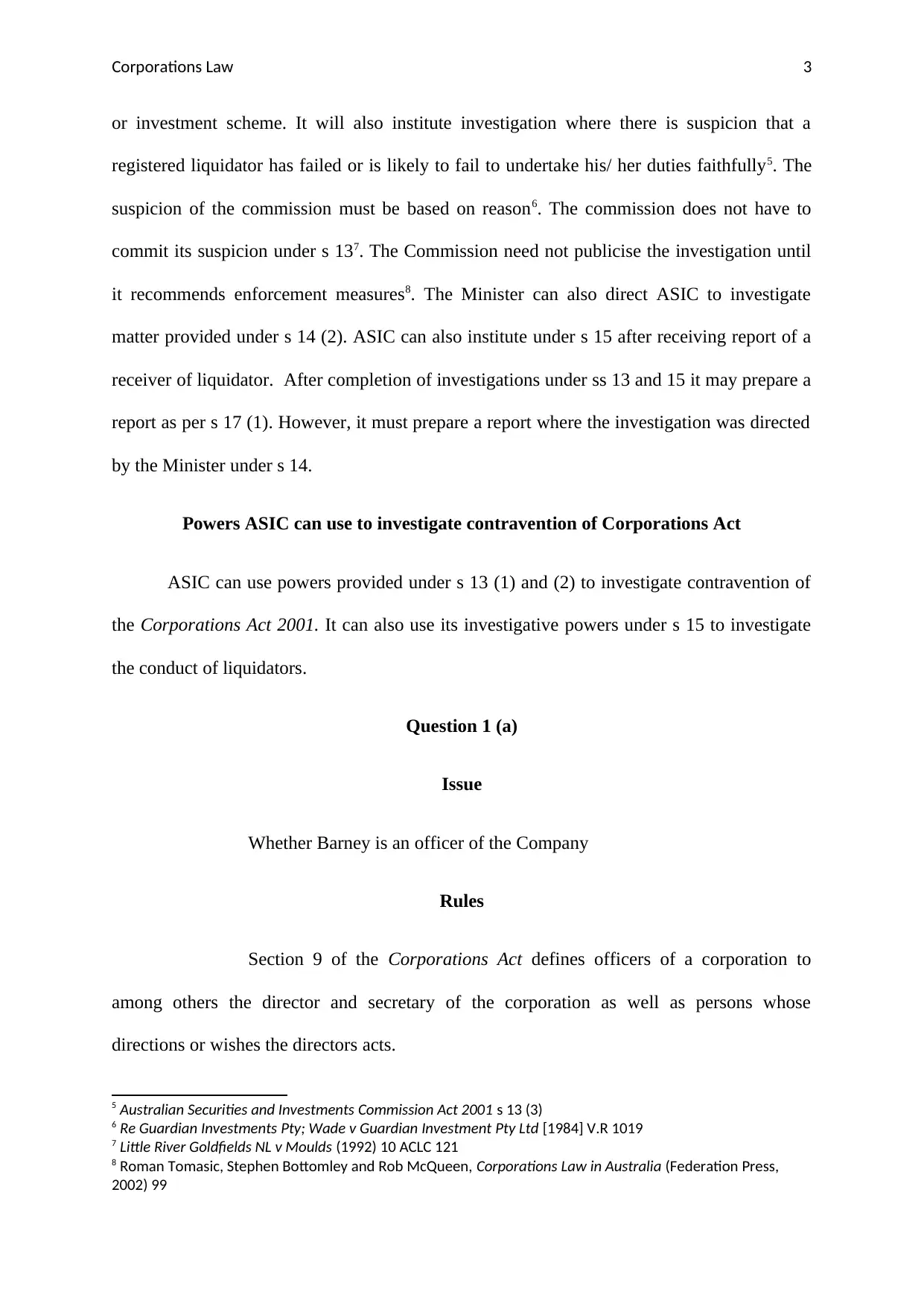
Corporations Law 3
or investment scheme. It will also institute investigation where there is suspicion that a
registered liquidator has failed or is likely to fail to undertake his/ her duties faithfully5. The
suspicion of the commission must be based on reason6. The commission does not have to
commit its suspicion under s 137. The Commission need not publicise the investigation until
it recommends enforcement measures8. The Minister can also direct ASIC to investigate
matter provided under s 14 (2). ASIC can also institute under s 15 after receiving report of a
receiver of liquidator. After completion of investigations under ss 13 and 15 it may prepare a
report as per s 17 (1). However, it must prepare a report where the investigation was directed
by the Minister under s 14.
Powers ASIC can use to investigate contravention of Corporations Act
ASIC can use powers provided under s 13 (1) and (2) to investigate contravention of
the Corporations Act 2001. It can also use its investigative powers under s 15 to investigate
the conduct of liquidators.
Question 1 (a)
Issue
Whether Barney is an officer of the Company
Rules
Section 9 of the Corporations Act defines officers of a corporation to
among others the director and secretary of the corporation as well as persons whose
directions or wishes the directors acts.
5 Australian Securities and Investments Commission Act 2001 s 13 (3)
6 Re Guardian Investments Pty; Wade v Guardian Investment Pty Ltd [1984] V.R 1019
7 Little River Goldfields NL v Moulds (1992) 10 ACLC 121
8 Roman Tomasic, Stephen Bottomley and Rob McQueen, Corporations Law in Australia (Federation Press,
2002) 99
or investment scheme. It will also institute investigation where there is suspicion that a
registered liquidator has failed or is likely to fail to undertake his/ her duties faithfully5. The
suspicion of the commission must be based on reason6. The commission does not have to
commit its suspicion under s 137. The Commission need not publicise the investigation until
it recommends enforcement measures8. The Minister can also direct ASIC to investigate
matter provided under s 14 (2). ASIC can also institute under s 15 after receiving report of a
receiver of liquidator. After completion of investigations under ss 13 and 15 it may prepare a
report as per s 17 (1). However, it must prepare a report where the investigation was directed
by the Minister under s 14.
Powers ASIC can use to investigate contravention of Corporations Act
ASIC can use powers provided under s 13 (1) and (2) to investigate contravention of
the Corporations Act 2001. It can also use its investigative powers under s 15 to investigate
the conduct of liquidators.
Question 1 (a)
Issue
Whether Barney is an officer of the Company
Rules
Section 9 of the Corporations Act defines officers of a corporation to
among others the director and secretary of the corporation as well as persons whose
directions or wishes the directors acts.
5 Australian Securities and Investments Commission Act 2001 s 13 (3)
6 Re Guardian Investments Pty; Wade v Guardian Investment Pty Ltd [1984] V.R 1019
7 Little River Goldfields NL v Moulds (1992) 10 ACLC 121
8 Roman Tomasic, Stephen Bottomley and Rob McQueen, Corporations Law in Australia (Federation Press,
2002) 99
⊘ This is a preview!⊘
Do you want full access?
Subscribe today to unlock all pages.

Trusted by 1+ million students worldwide
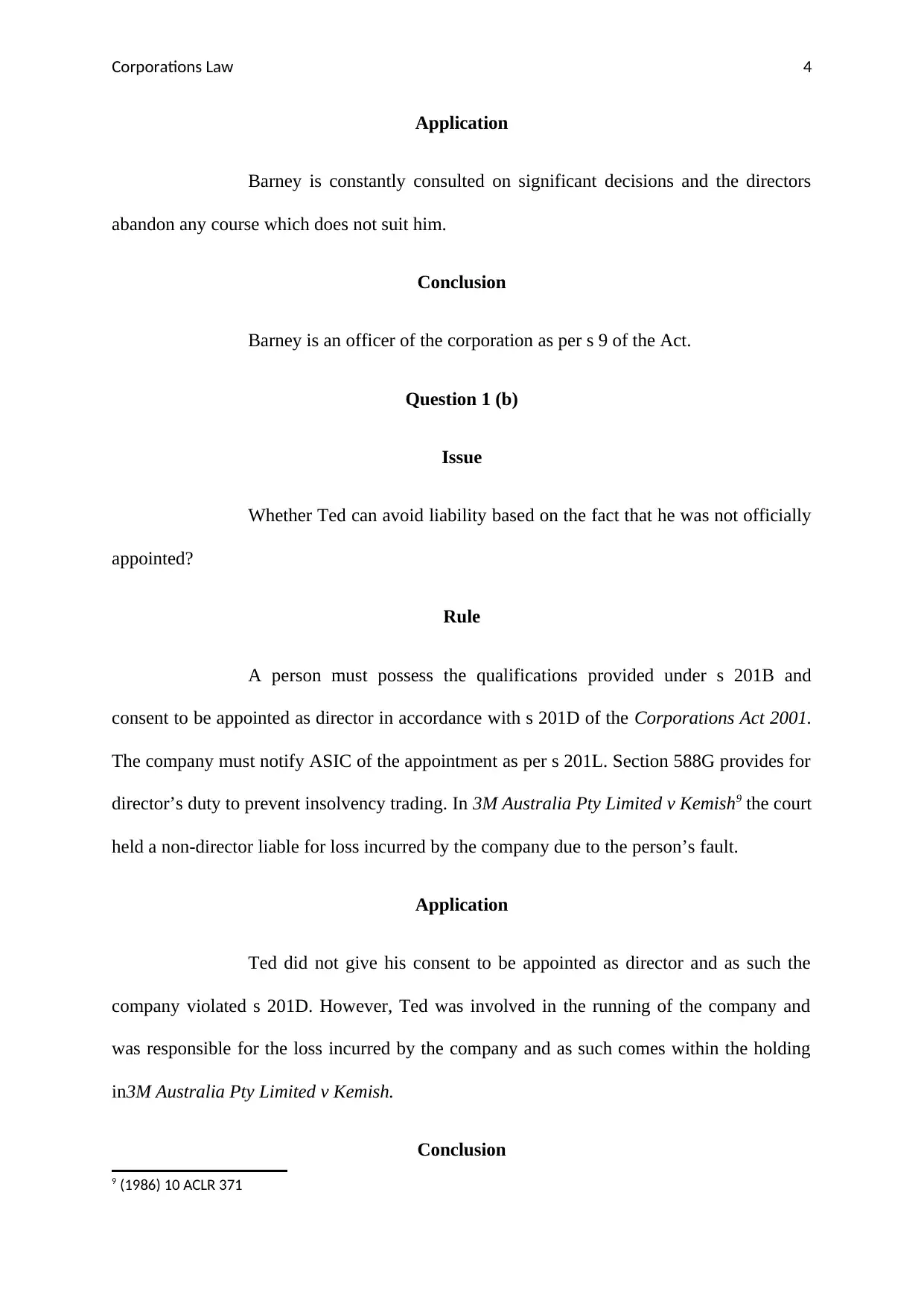
Corporations Law 4
Application
Barney is constantly consulted on significant decisions and the directors
abandon any course which does not suit him.
Conclusion
Barney is an officer of the corporation as per s 9 of the Act.
Question 1 (b)
Issue
Whether Ted can avoid liability based on the fact that he was not officially
appointed?
Rule
A person must possess the qualifications provided under s 201B and
consent to be appointed as director in accordance with s 201D of the Corporations Act 2001.
The company must notify ASIC of the appointment as per s 201L. Section 588G provides for
director’s duty to prevent insolvency trading. In 3M Australia Pty Limited v Kemish9 the court
held a non-director liable for loss incurred by the company due to the person’s fault.
Application
Ted did not give his consent to be appointed as director and as such the
company violated s 201D. However, Ted was involved in the running of the company and
was responsible for the loss incurred by the company and as such comes within the holding
in3M Australia Pty Limited v Kemish.
Conclusion
9 (1986) 10 ACLR 371
Application
Barney is constantly consulted on significant decisions and the directors
abandon any course which does not suit him.
Conclusion
Barney is an officer of the corporation as per s 9 of the Act.
Question 1 (b)
Issue
Whether Ted can avoid liability based on the fact that he was not officially
appointed?
Rule
A person must possess the qualifications provided under s 201B and
consent to be appointed as director in accordance with s 201D of the Corporations Act 2001.
The company must notify ASIC of the appointment as per s 201L. Section 588G provides for
director’s duty to prevent insolvency trading. In 3M Australia Pty Limited v Kemish9 the court
held a non-director liable for loss incurred by the company due to the person’s fault.
Application
Ted did not give his consent to be appointed as director and as such the
company violated s 201D. However, Ted was involved in the running of the company and
was responsible for the loss incurred by the company and as such comes within the holding
in3M Australia Pty Limited v Kemish.
Conclusion
9 (1986) 10 ACLR 371
Paraphrase This Document
Need a fresh take? Get an instant paraphrase of this document with our AI Paraphraser
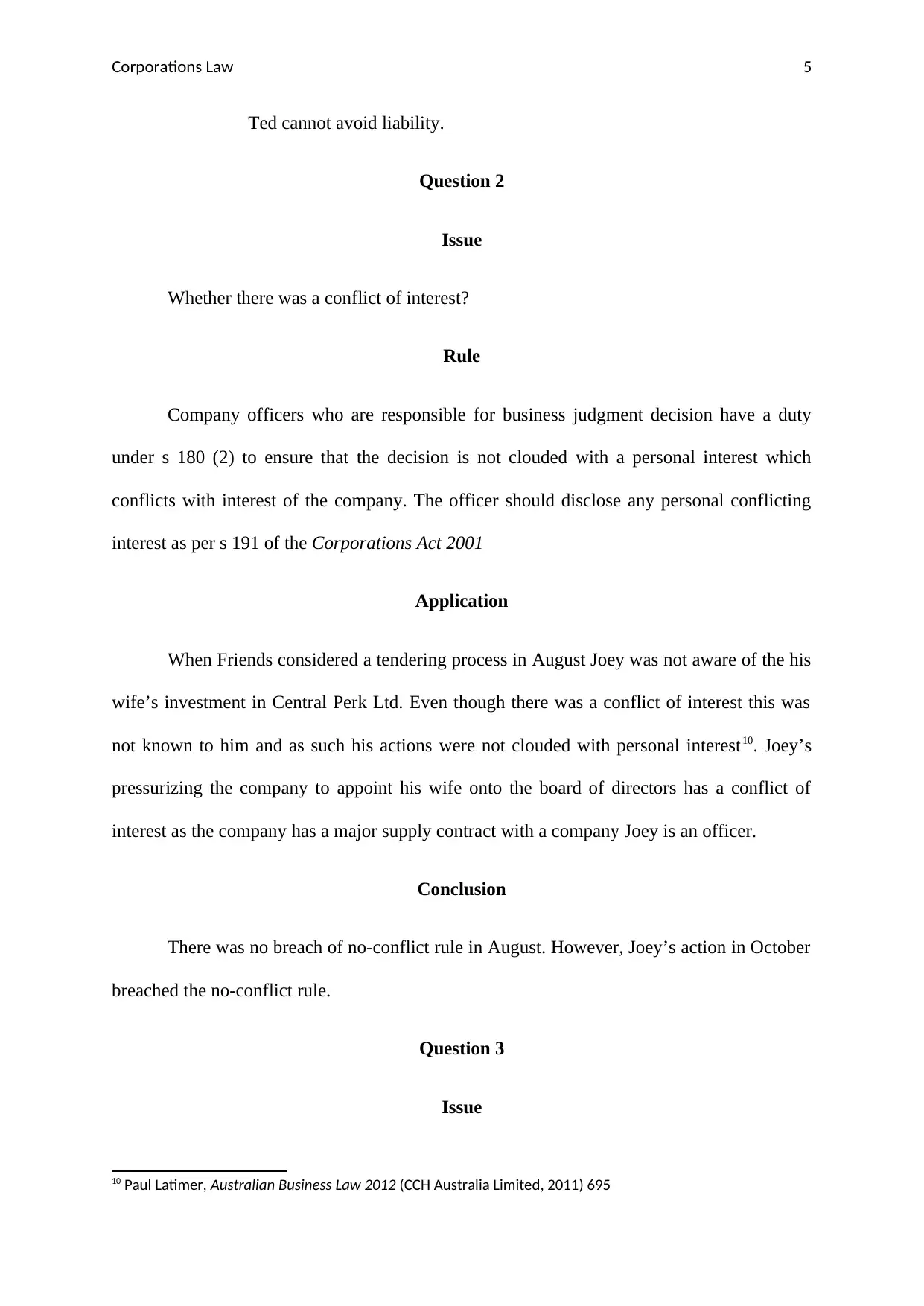
Corporations Law 5
Ted cannot avoid liability.
Question 2
Issue
Whether there was a conflict of interest?
Rule
Company officers who are responsible for business judgment decision have a duty
under s 180 (2) to ensure that the decision is not clouded with a personal interest which
conflicts with interest of the company. The officer should disclose any personal conflicting
interest as per s 191 of the Corporations Act 2001
Application
When Friends considered a tendering process in August Joey was not aware of the his
wife’s investment in Central Perk Ltd. Even though there was a conflict of interest this was
not known to him and as such his actions were not clouded with personal interest10. Joey’s
pressurizing the company to appoint his wife onto the board of directors has a conflict of
interest as the company has a major supply contract with a company Joey is an officer.
Conclusion
There was no breach of no-conflict rule in August. However, Joey’s action in October
breached the no-conflict rule.
Question 3
Issue
10 Paul Latimer, Australian Business Law 2012 (CCH Australia Limited, 2011) 695
Ted cannot avoid liability.
Question 2
Issue
Whether there was a conflict of interest?
Rule
Company officers who are responsible for business judgment decision have a duty
under s 180 (2) to ensure that the decision is not clouded with a personal interest which
conflicts with interest of the company. The officer should disclose any personal conflicting
interest as per s 191 of the Corporations Act 2001
Application
When Friends considered a tendering process in August Joey was not aware of the his
wife’s investment in Central Perk Ltd. Even though there was a conflict of interest this was
not known to him and as such his actions were not clouded with personal interest10. Joey’s
pressurizing the company to appoint his wife onto the board of directors has a conflict of
interest as the company has a major supply contract with a company Joey is an officer.
Conclusion
There was no breach of no-conflict rule in August. However, Joey’s action in October
breached the no-conflict rule.
Question 3
Issue
10 Paul Latimer, Australian Business Law 2012 (CCH Australia Limited, 2011) 695
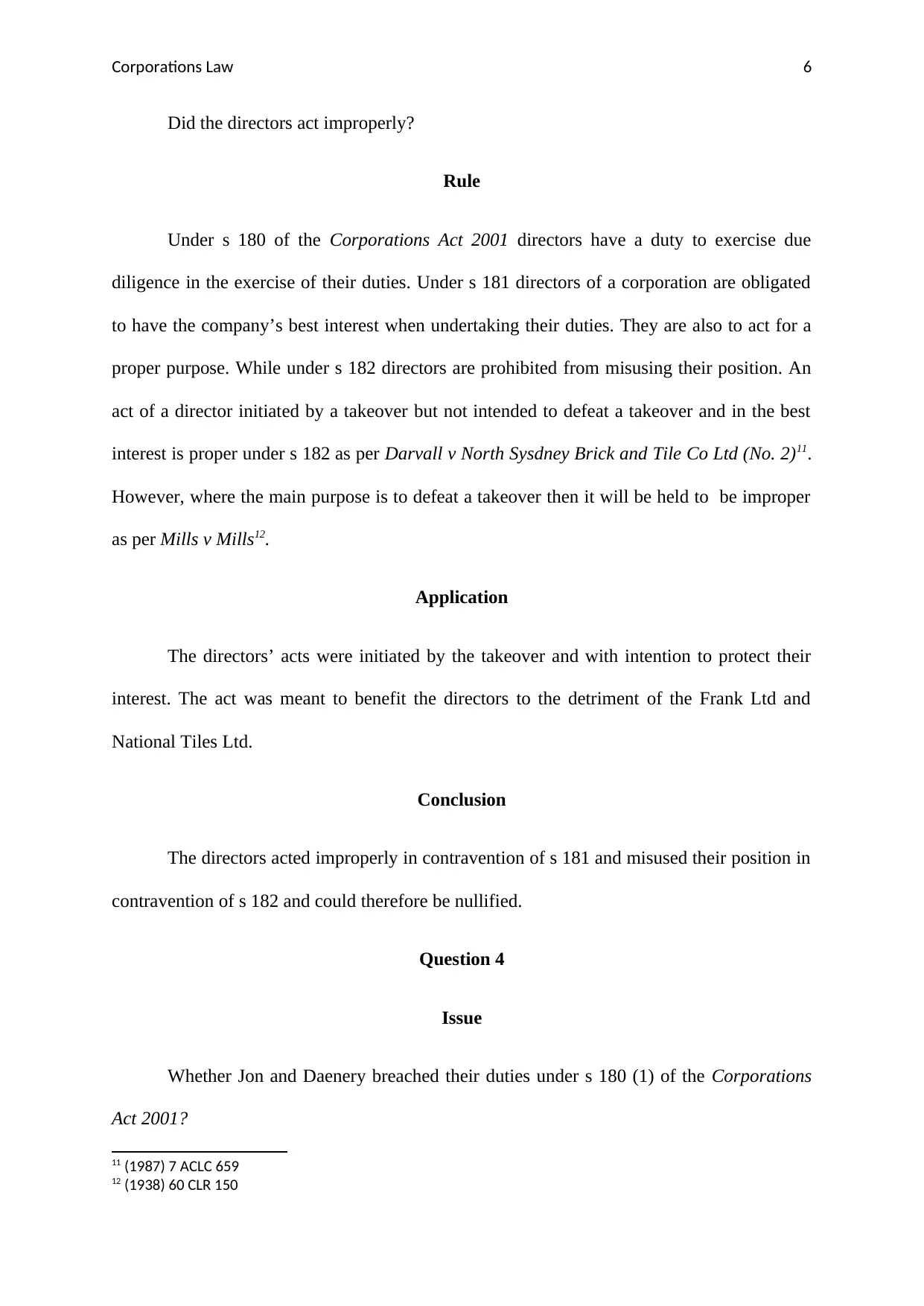
Corporations Law 6
Did the directors act improperly?
Rule
Under s 180 of the Corporations Act 2001 directors have a duty to exercise due
diligence in the exercise of their duties. Under s 181 directors of a corporation are obligated
to have the company’s best interest when undertaking their duties. They are also to act for a
proper purpose. While under s 182 directors are prohibited from misusing their position. An
act of a director initiated by a takeover but not intended to defeat a takeover and in the best
interest is proper under s 182 as per Darvall v North Sysdney Brick and Tile Co Ltd (No. 2)11.
However, where the main purpose is to defeat a takeover then it will be held to be improper
as per Mills v Mills12.
Application
The directors’ acts were initiated by the takeover and with intention to protect their
interest. The act was meant to benefit the directors to the detriment of the Frank Ltd and
National Tiles Ltd.
Conclusion
The directors acted improperly in contravention of s 181 and misused their position in
contravention of s 182 and could therefore be nullified.
Question 4
Issue
Whether Jon and Daenery breached their duties under s 180 (1) of the Corporations
Act 2001?
11 (1987) 7 ACLC 659
12 (1938) 60 CLR 150
Did the directors act improperly?
Rule
Under s 180 of the Corporations Act 2001 directors have a duty to exercise due
diligence in the exercise of their duties. Under s 181 directors of a corporation are obligated
to have the company’s best interest when undertaking their duties. They are also to act for a
proper purpose. While under s 182 directors are prohibited from misusing their position. An
act of a director initiated by a takeover but not intended to defeat a takeover and in the best
interest is proper under s 182 as per Darvall v North Sysdney Brick and Tile Co Ltd (No. 2)11.
However, where the main purpose is to defeat a takeover then it will be held to be improper
as per Mills v Mills12.
Application
The directors’ acts were initiated by the takeover and with intention to protect their
interest. The act was meant to benefit the directors to the detriment of the Frank Ltd and
National Tiles Ltd.
Conclusion
The directors acted improperly in contravention of s 181 and misused their position in
contravention of s 182 and could therefore be nullified.
Question 4
Issue
Whether Jon and Daenery breached their duties under s 180 (1) of the Corporations
Act 2001?
11 (1987) 7 ACLC 659
12 (1938) 60 CLR 150
⊘ This is a preview!⊘
Do you want full access?
Subscribe today to unlock all pages.

Trusted by 1+ million students worldwide
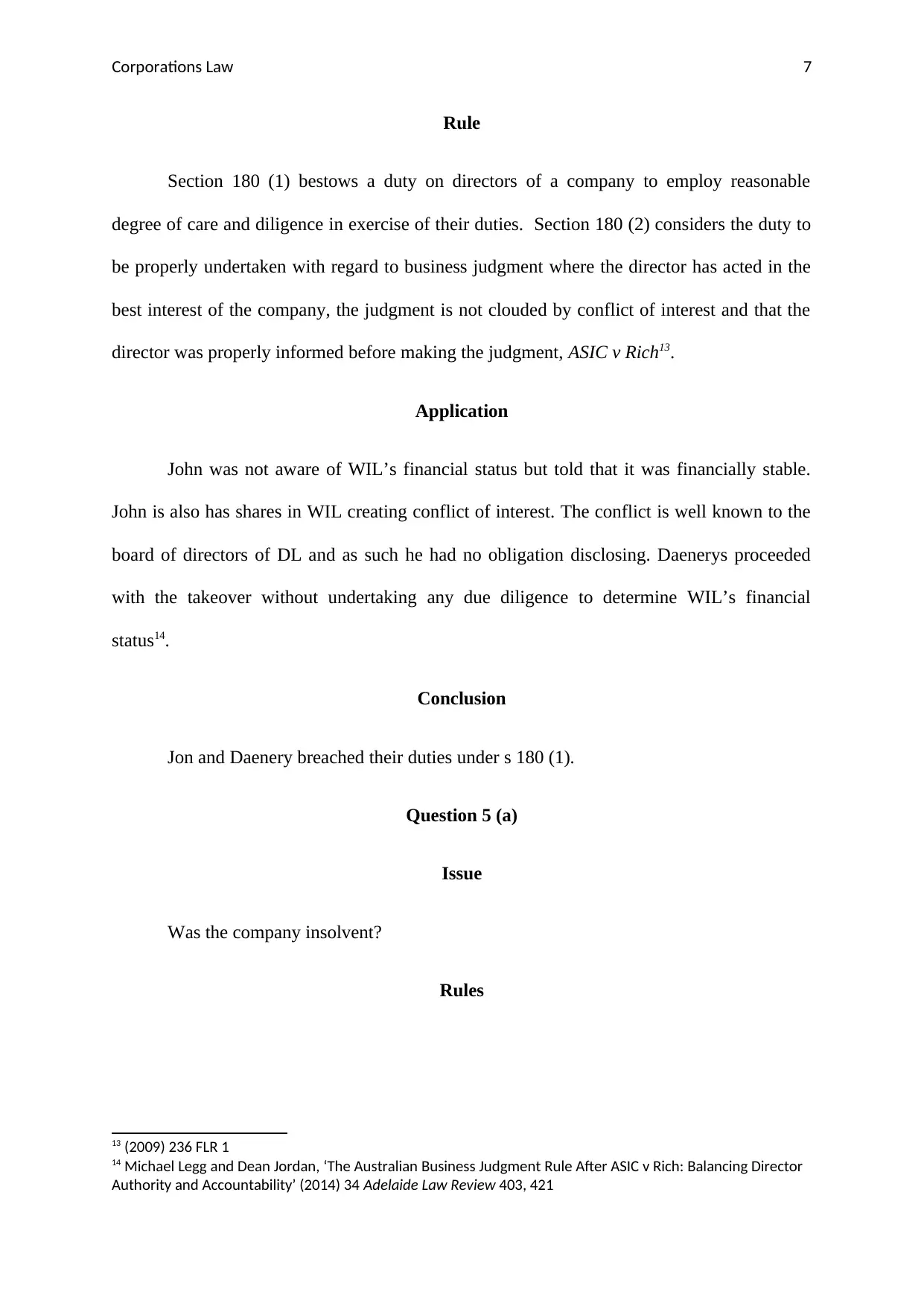
Corporations Law 7
Rule
Section 180 (1) bestows a duty on directors of a company to employ reasonable
degree of care and diligence in exercise of their duties. Section 180 (2) considers the duty to
be properly undertaken with regard to business judgment where the director has acted in the
best interest of the company, the judgment is not clouded by conflict of interest and that the
director was properly informed before making the judgment, ASIC v Rich13.
Application
John was not aware of WIL’s financial status but told that it was financially stable.
John is also has shares in WIL creating conflict of interest. The conflict is well known to the
board of directors of DL and as such he had no obligation disclosing. Daenerys proceeded
with the takeover without undertaking any due diligence to determine WIL’s financial
status14.
Conclusion
Jon and Daenery breached their duties under s 180 (1).
Question 5 (a)
Issue
Was the company insolvent?
Rules
13 (2009) 236 FLR 1
14 Michael Legg and Dean Jordan, ‘The Australian Business Judgment Rule After ASIC v Rich: Balancing Director
Authority and Accountability’ (2014) 34 Adelaide Law Review 403, 421
Rule
Section 180 (1) bestows a duty on directors of a company to employ reasonable
degree of care and diligence in exercise of their duties. Section 180 (2) considers the duty to
be properly undertaken with regard to business judgment where the director has acted in the
best interest of the company, the judgment is not clouded by conflict of interest and that the
director was properly informed before making the judgment, ASIC v Rich13.
Application
John was not aware of WIL’s financial status but told that it was financially stable.
John is also has shares in WIL creating conflict of interest. The conflict is well known to the
board of directors of DL and as such he had no obligation disclosing. Daenerys proceeded
with the takeover without undertaking any due diligence to determine WIL’s financial
status14.
Conclusion
Jon and Daenery breached their duties under s 180 (1).
Question 5 (a)
Issue
Was the company insolvent?
Rules
13 (2009) 236 FLR 1
14 Michael Legg and Dean Jordan, ‘The Australian Business Judgment Rule After ASIC v Rich: Balancing Director
Authority and Accountability’ (2014) 34 Adelaide Law Review 403, 421
Paraphrase This Document
Need a fresh take? Get an instant paraphrase of this document with our AI Paraphraser
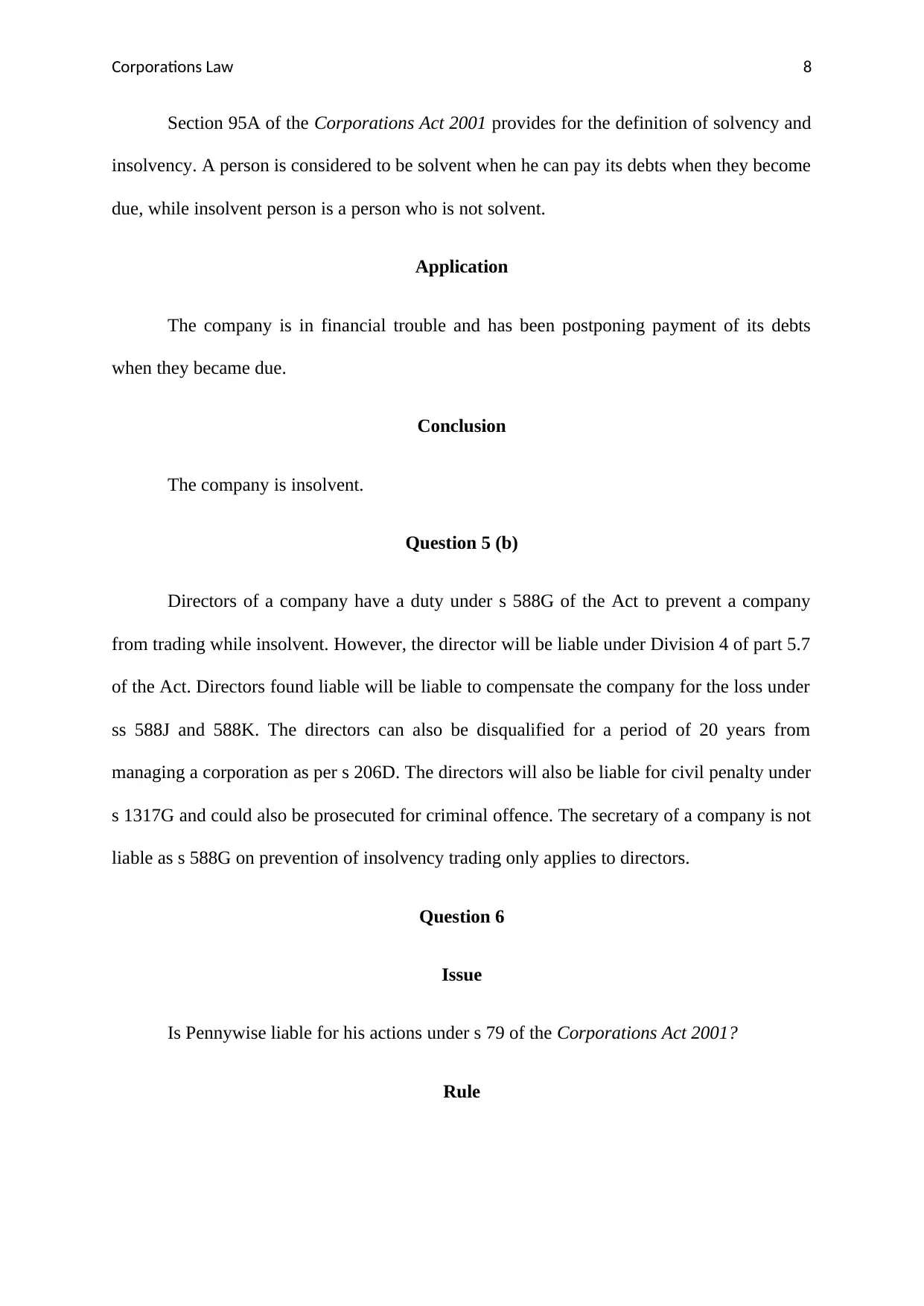
Corporations Law 8
Section 95A of the Corporations Act 2001 provides for the definition of solvency and
insolvency. A person is considered to be solvent when he can pay its debts when they become
due, while insolvent person is a person who is not solvent.
Application
The company is in financial trouble and has been postponing payment of its debts
when they became due.
Conclusion
The company is insolvent.
Question 5 (b)
Directors of a company have a duty under s 588G of the Act to prevent a company
from trading while insolvent. However, the director will be liable under Division 4 of part 5.7
of the Act. Directors found liable will be liable to compensate the company for the loss under
ss 588J and 588K. The directors can also be disqualified for a period of 20 years from
managing a corporation as per s 206D. The directors will also be liable for civil penalty under
s 1317G and could also be prosecuted for criminal offence. The secretary of a company is not
liable as s 588G on prevention of insolvency trading only applies to directors.
Question 6
Issue
Is Pennywise liable for his actions under s 79 of the Corporations Act 2001?
Rule
Section 95A of the Corporations Act 2001 provides for the definition of solvency and
insolvency. A person is considered to be solvent when he can pay its debts when they become
due, while insolvent person is a person who is not solvent.
Application
The company is in financial trouble and has been postponing payment of its debts
when they became due.
Conclusion
The company is insolvent.
Question 5 (b)
Directors of a company have a duty under s 588G of the Act to prevent a company
from trading while insolvent. However, the director will be liable under Division 4 of part 5.7
of the Act. Directors found liable will be liable to compensate the company for the loss under
ss 588J and 588K. The directors can also be disqualified for a period of 20 years from
managing a corporation as per s 206D. The directors will also be liable for civil penalty under
s 1317G and could also be prosecuted for criminal offence. The secretary of a company is not
liable as s 588G on prevention of insolvency trading only applies to directors.
Question 6
Issue
Is Pennywise liable for his actions under s 79 of the Corporations Act 2001?
Rule
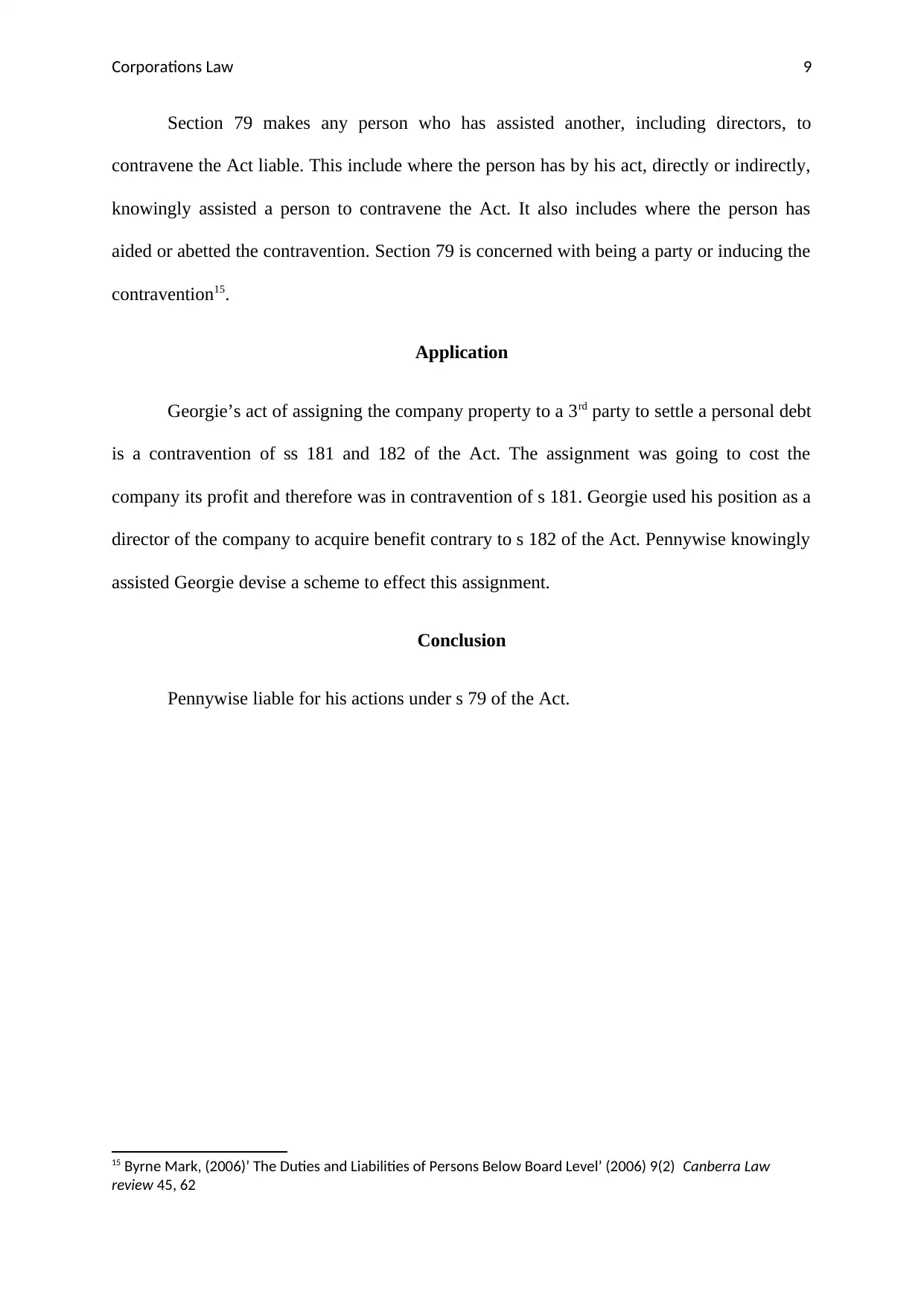
Corporations Law 9
Section 79 makes any person who has assisted another, including directors, to
contravene the Act liable. This include where the person has by his act, directly or indirectly,
knowingly assisted a person to contravene the Act. It also includes where the person has
aided or abetted the contravention. Section 79 is concerned with being a party or inducing the
contravention15.
Application
Georgie’s act of assigning the company property to a 3rd party to settle a personal debt
is a contravention of ss 181 and 182 of the Act. The assignment was going to cost the
company its profit and therefore was in contravention of s 181. Georgie used his position as a
director of the company to acquire benefit contrary to s 182 of the Act. Pennywise knowingly
assisted Georgie devise a scheme to effect this assignment.
Conclusion
Pennywise liable for his actions under s 79 of the Act.
15 Byrne Mark, (2006)’ The Duties and Liabilities of Persons Below Board Level’ (2006) 9(2) Canberra Law
review 45, 62
Section 79 makes any person who has assisted another, including directors, to
contravene the Act liable. This include where the person has by his act, directly or indirectly,
knowingly assisted a person to contravene the Act. It also includes where the person has
aided or abetted the contravention. Section 79 is concerned with being a party or inducing the
contravention15.
Application
Georgie’s act of assigning the company property to a 3rd party to settle a personal debt
is a contravention of ss 181 and 182 of the Act. The assignment was going to cost the
company its profit and therefore was in contravention of s 181. Georgie used his position as a
director of the company to acquire benefit contrary to s 182 of the Act. Pennywise knowingly
assisted Georgie devise a scheme to effect this assignment.
Conclusion
Pennywise liable for his actions under s 79 of the Act.
15 Byrne Mark, (2006)’ The Duties and Liabilities of Persons Below Board Level’ (2006) 9(2) Canberra Law
review 45, 62
⊘ This is a preview!⊘
Do you want full access?
Subscribe today to unlock all pages.

Trusted by 1+ million students worldwide
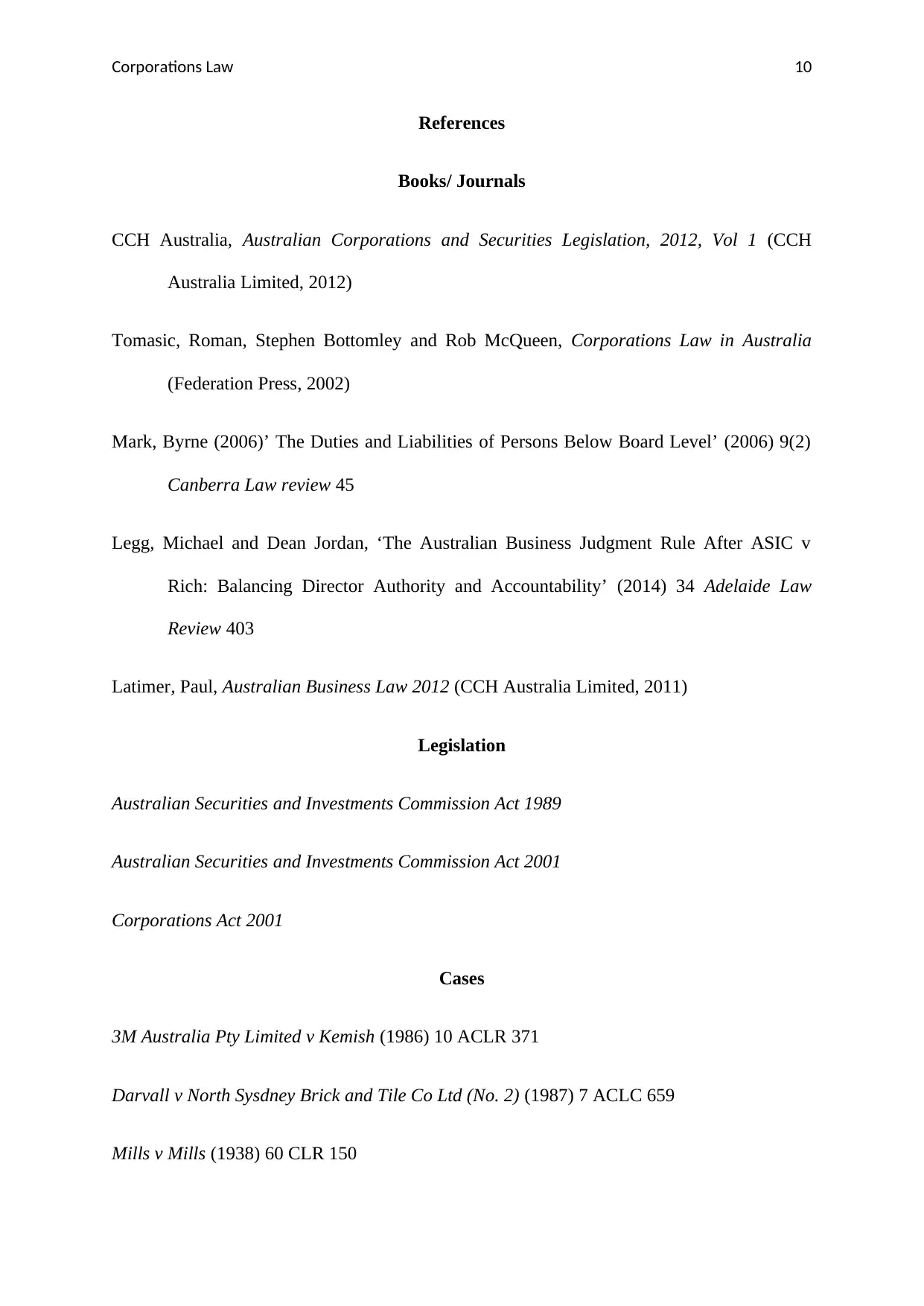
Corporations Law 10
References
Books/ Journals
CCH Australia, Australian Corporations and Securities Legislation, 2012, Vol 1 (CCH
Australia Limited, 2012)
Tomasic, Roman, Stephen Bottomley and Rob McQueen, Corporations Law in Australia
(Federation Press, 2002)
Mark, Byrne (2006)’ The Duties and Liabilities of Persons Below Board Level’ (2006) 9(2)
Canberra Law review 45
Legg, Michael and Dean Jordan, ‘The Australian Business Judgment Rule After ASIC v
Rich: Balancing Director Authority and Accountability’ (2014) 34 Adelaide Law
Review 403
Latimer, Paul, Australian Business Law 2012 (CCH Australia Limited, 2011)
Legislation
Australian Securities and Investments Commission Act 1989
Australian Securities and Investments Commission Act 2001
Corporations Act 2001
Cases
3M Australia Pty Limited v Kemish (1986) 10 ACLR 371
Darvall v North Sysdney Brick and Tile Co Ltd (No. 2) (1987) 7 ACLC 659
Mills v Mills (1938) 60 CLR 150
References
Books/ Journals
CCH Australia, Australian Corporations and Securities Legislation, 2012, Vol 1 (CCH
Australia Limited, 2012)
Tomasic, Roman, Stephen Bottomley and Rob McQueen, Corporations Law in Australia
(Federation Press, 2002)
Mark, Byrne (2006)’ The Duties and Liabilities of Persons Below Board Level’ (2006) 9(2)
Canberra Law review 45
Legg, Michael and Dean Jordan, ‘The Australian Business Judgment Rule After ASIC v
Rich: Balancing Director Authority and Accountability’ (2014) 34 Adelaide Law
Review 403
Latimer, Paul, Australian Business Law 2012 (CCH Australia Limited, 2011)
Legislation
Australian Securities and Investments Commission Act 1989
Australian Securities and Investments Commission Act 2001
Corporations Act 2001
Cases
3M Australia Pty Limited v Kemish (1986) 10 ACLR 371
Darvall v North Sysdney Brick and Tile Co Ltd (No. 2) (1987) 7 ACLC 659
Mills v Mills (1938) 60 CLR 150
Paraphrase This Document
Need a fresh take? Get an instant paraphrase of this document with our AI Paraphraser
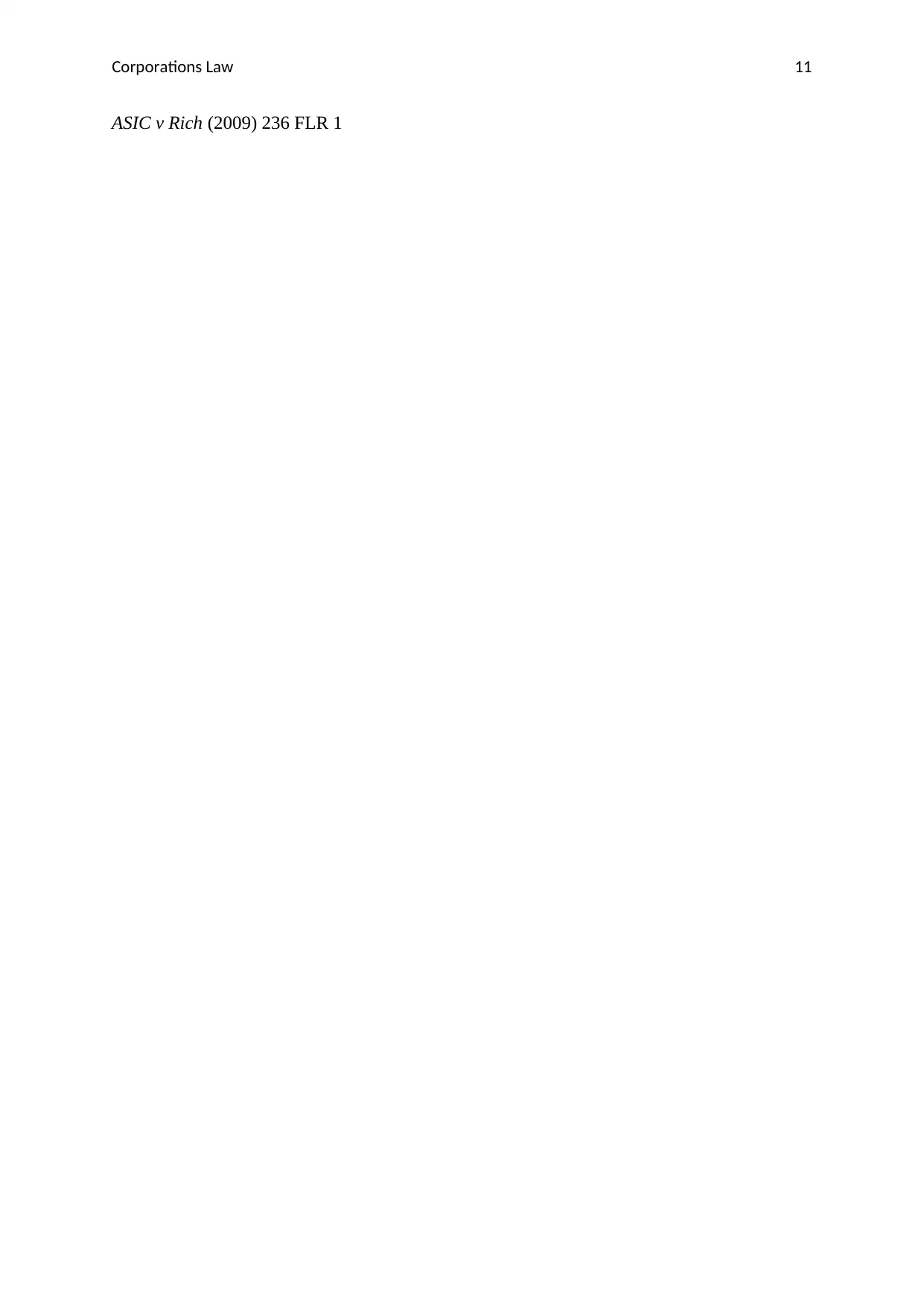
Corporations Law 11
ASIC v Rich (2009) 236 FLR 1
ASIC v Rich (2009) 236 FLR 1
1 out of 11
Related Documents
Your All-in-One AI-Powered Toolkit for Academic Success.
+13062052269
info@desklib.com
Available 24*7 on WhatsApp / Email
![[object Object]](/_next/static/media/star-bottom.7253800d.svg)
Unlock your academic potential
Copyright © 2020–2025 A2Z Services. All Rights Reserved. Developed and managed by ZUCOL.





